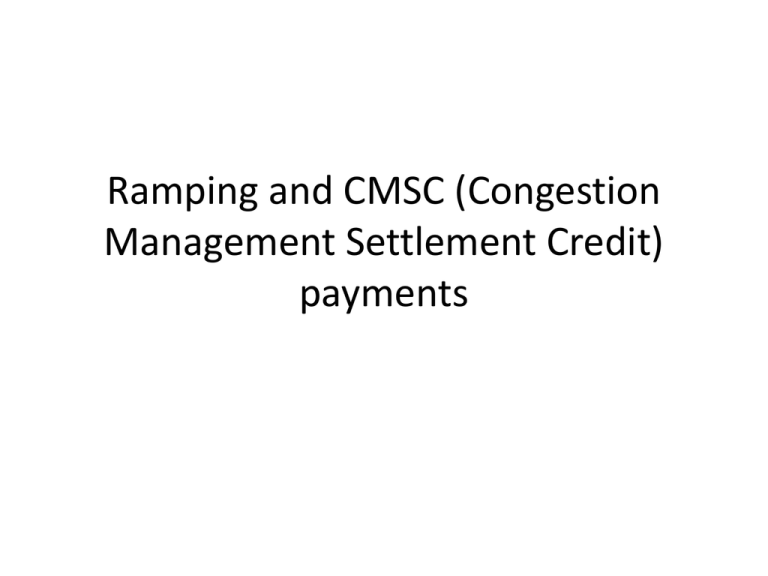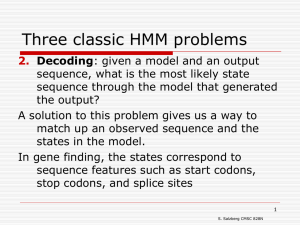CMSC for RAMPING
advertisement

Ramping and CMSC (Congestion Management Settlement Credit) payments • The IESO administers the wholesale electricity markets in Ontario. It operates a real-time energy market, in which electricity demand and supply are balanced and instructions are issued to dispatchable generators and loads every five minutes as well as to intertie traders on an hourly basis. The IESO selects the most economic offers from generators and importers as well as bids from dispatchable loads and exporters in order to match the supply and consumption of electricity for each five-minute interval. The outputs of this process include dispatch quantities and the Market Clearing Price (“MCP”). The simple average of the 12 interval MCPs in an hour is the HOEP. • The real-time wholesale electricity market is a uniform-price market in which suppliers (generators and importers) generally receive, and wholesale customers (including dispatchable and non-dispatchable loads as well as exporters) generally pay, a system-wide market price for electricity irrespective of their location in Ontario. The decision to adopt a uniform-price market, rather than a market in which prices vary by location, has resulted in a “two-schedule” system in order to deal with differences between the province-wide “market” (or “unconstrained”) demand/supply and the physical capabilities of the system which results in the need for the IESO to “constrain” market participants in order to deal with localized demand/supply imbalances. • The price for generators and dispatchable loads is the MCP for each interval. Non-dispatchable loads pay the HOEP. Export and import transactions are also based on the HOEP, subject to adjustments related to localized intertie congestion. • A dispatchable generator is “constrained on” when the constrained schedule dispatches it to produce more electricity than is indicated in the unconstrained schedule. Conversely, a dispatchable generator is “constrained off” when the constrained schedule dispatches it to produce less electricity than is indicated in the unconstrained schedule. As discussed below, CMSC payments may be triggered when a dispatchable facility is constrained on or constrained off. • In the case of dispatchable generators, CMSC payments are intended to compensate the market participant when, based on the constrained schedule, the IESO instructs it to supply electricity in an amount that is less profitable for the participant relative to the operating profit that would have been expected from generating or consuming at the level indicated for the participant in the unconstrained schedule. • CMSC payments arose from the decision to adopt a uniform-price market and the two-schedule system. The Market Design Committee (“MDC”) – the committee charged with designing a competitive electricity market for Ontario – proposed such payments to compensate dispatchable facilities for reductions in their operating profits that resulted from responding to system operator instructions to alter their output or consumption in order to relieve transmission constraints: • The CMSC payment for a dispatchable generator in any five-minute interval is effectively calculated as the difference between its offer price and the MCP, multiplied by the difference between its unconstrained schedule and constrained schedule quantities. As the quantity differences between the two schedules increase, so too do the associated CMSC payments. • CMSC payments made by the IESO are recovered from wholesale market participants based on their respective withdrawals from the IESO-controlled grid (in other words, based on their consumption) through what is referred to as an “uplift” charge. In the case of an electricity distributor, uplift charges paid by the distributor to the IESO are ultimately passed through to the distributor’s own customers (or, where applicable, to any embedded distributors who in turn pass the charges through to their respective customers ). • • When determining the constrained schedules for a market participant, the constrained mode uses the ramp rates submitted by the market participant. However, in determining the unconstrained schedules the unconstrained mode assumes that a facility can ramp up or down three times faster than reflected in the ramp rates submitted by the market participant (referred to as the “3x Ramp Rate Multiplier”). • As a result of the 3x Ramp Rate Multiplier, the quantity in the unconstrained schedule for a generation facility that is ramping up or down will, all else being equal, always differ from the quantity in the constrained schedule; specifically, when the generation facility is ramping down, the constrained schedule is greater (in MW terms) than the unconstrained schedule and when the generation facility is ramping up, the constrained schedule is less (in MW terms) than the unconstrained schedule. • All else being equal, the 3x Ramp Rate Multiplier results in the generation facility being treated as constrained on (during ramp down) or constrained off (during ramp up) during the ramping period, and receiving CMSC payments as a result. • All else being equal, the 3x Ramp Rate Multiplier results in the generation facility being treated as constrained on (during ramp down) or constrained off (during ramp up) during the ramping period, and receiving CMSC payments as a result. Quantity differences under slow and fast ramp rates Time Slow Ramp Constrained Constrained Unconstrained Unconstrained MW MW Fast Ramp Time • All ramping events will induce CMSC payments (including those dispatched for legitimate efficiency reasons by the system operator), but by manipulating the offer price, generators (and loads) can “game the system” and generate large CMSC payments for themselves which have no efficiency component at all. As a result of the 3x Ramp Rate Multiplier, the quantity in the unconstrained schedule for a generation facility that is ramping up or down will, all else being equal, always differ from the quantity in the constrained schedule; specifically, when the generation facility is ramping down, the constrained schedule is greater (in MW terms) than the unconstrained schedule and when the generation facility is ramping up, the constrained schedule is less (in MW terms) than the unconstrained schedule. • The amount of CMSC payments to a generator during ramp-down depends on: • The generator’s submitted ramp rate. The slower the ramp rate, the higher the quantity difference between the constrained and unconstrained schedules and the higher the CMSC payments. • The number of times that a generator ramps down. All other things being equal, more frequent ramping leads to more CMSC payments being made. • The generator’s offer price for the ramp-down hour. Higher offer prices lead to higher CMSC payments. Time Slow Ramp Constrained Constrained Unconstrained Unconstrained MW MW Fast Ramp Time Computing Ramp Down CMSC Unconstrained 3X ramp rate Constrained (actual) ramp rate A B











